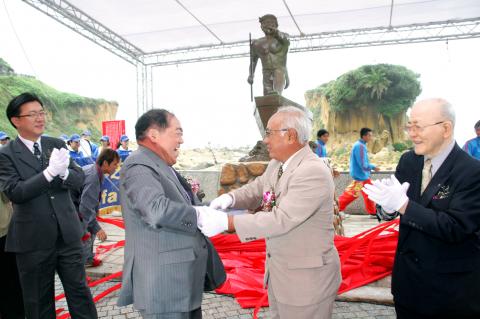Braving strong winds, rain and waves pounding the shore, officials and residents from Keelung and Japan’s Okinawa Prefecture yesterday jointly unveiled a statue of an Okinawan fisherman with cheers, music and words of friendship to commemorate Okinawans who died during the 228 Incident.
The ceremony started with a Buddhist rite, hosted by the head monk from Seikoji Temple in Okinawa, at Wanshantang — a small temple with urns containing bones and ashes of people of unknown identity or those who died without descendants — near the monument on Keelung’s Heping Island (和平島), which is just off Taiwan proper.
Bodies of Okinawan fishermen, including more than 30 of them who were killed by Chinese Nationalist Party (KMT) troops in the 228 Incident, were buried at Wanshantang.

Photo: Loa Iok-sin, Taipei Times
The 228 Incident refers to the large-scale uprising across the island in 1947 against the KMT regime, which was put down in a violent crackdown.
“We’ve always heard that some of our ancestors are here in Keelung and the people of the city have always remembered them in religious rites,” the monk said. “We’re holding a religious rite and have erected a monument here to comfort the spirits of our ancestors.”
“Meanwhile, we would also like to express our gratitude to the people of Keelung,” the monk added.
Chou Chen-tsai (周振才), a board member of the 228 Care Association, said that from about 1905 to the end of World War II, as many as 500 fishermen from Okinawa, whose former name was Ryukyu, had settled on Heping Island, forming a “Ryukyu village” there, and lived side by side with Taiwanese.
Many Okinawan fishermen stayed after the end of the war and some were killed during the massacre in 1947.
“That there were Okinawan victims of the 228 Incident are not known among the public, but we’ve always heard about it from locals. So, around eight years ago, organizations of the 228 Incident and historians launched a research project in both Taiwan and Okinawa and have confirmed it as fact,” Chou said.
“That’s why we’re erecting a monument here, not only to remember the deceased, but also to remind the public about the forgotten history,” Chou added.
The religious rite was followed by a ceremony to unveil the monument by Keelung Mayor Chang Tong-rong (張通榮) and Toshihiko Simoji, mayor of Miyakojima City in Okinawa Prefecture, where many of the Okinawan fishermen who settled on Heping Island came from.
The mayors thanked each other for their help in erecting the statue and expressed the hope that the monument would help to enhance exchanges between the two cities, which were quite frequent before 1945.
Many Okinawans whose ancestors had once lived on Heping Island also attended the ceremony — among them was Shiosei Yashumoto, whose great-uncle, Chouzou Uchima, lived on Heping Island from 1905 to 1945, and was the model for the fisherman statue.
“My great uncle lived in Taiwan from 1905 to 1945. He was a good friend of Taiwanese, he taught them some fishing techniques unique to Okinawa and gave his Taiwanese friends fish during wartime when the [Japanese colonial] government prohibited selling fish to the Taiwanese,” Yashumoto said through a translator. “He was even arrested for that, but he was released by arguing that he didn’t ‘sell’ the fish, rather, people took it from him for free.”

Taiwan is to commence mass production of the Tien Kung (天弓, “Sky Bow”) III, IV and V missiles by the second quarter of this year if the legislature approves the government’s NT$1.25 trillion (US$39.78 billion) special defense budget, an official said yesterday. Commenting on condition of anonymity, a defense official with knowledge of the matter said that the advanced systems are expected to provide crucial capabilities against ballistic and cruise missiles for the proposed “T-Dome,” an advanced, multi-layered air defense network. The Tien Kung III is an air defense missile with a maximum interception altitude of 35km. The Tien Kung IV and V

The disruption of 941 flights in and out of Taiwan due to China’s large-scale military exercises was no accident, but rather the result of a “quasi-blockade” used to simulate creating the air and sea routes needed for an amphibious landing, a military expert said. The disruptions occurred on Tuesday and lasted about 10 hours as China conducted live-fire drills in the Taiwan Strait. The Civil Aviation Administration (CAA) said the exercises affected 857 international flights and 84 domestic flights, affecting more than 100,000 travelers. Su Tzu-yun (蘇紫雲), a research fellow at the government-sponsored Institute for National Defense and Security Research, said the air

Taiwan lacks effective and cost-efficient armaments to intercept rockets, making the planned “T-Dome” interception system necessary, two experts said on Tuesday. The concerns were raised after China’s military fired two waves of rockets during live-fire drills around Taiwan on Tuesday, part of two-day exercises code-named “Justice Mission 2025.” The first wave involved 17 rockets launched at 9am from Pingtan in China’s Fujian Province, according to Lieutenant General Hsieh Jih-sheng (謝日升) of the Office of the Deputy Chief of the General Staff for Intelligence at the Ministry of National Defense. Those rockets landed 70 nautical miles (129.6km) northeast of Keelung without flying over Taiwan,

A strong continental cold air mass is to bring pollutants to Taiwan from tomorrow, the Ministry of Environment said today, as it issued an “orange” air quality alert for most of the country. All of Taiwan except for Hualien and Taitung counties is to be under an “orange” air quality alert tomorrow, indicating air quality that is unhealthy for sensitive groups. In China, areas from Shandong to Shanghai have been enveloped in haze since Saturday, the ministry said in a news release. Yesterday, hourly concentrations of PM2.5 in these areas ranged from 65 to 160 micrograms per cubic meter (mg/m³), and pollutants were